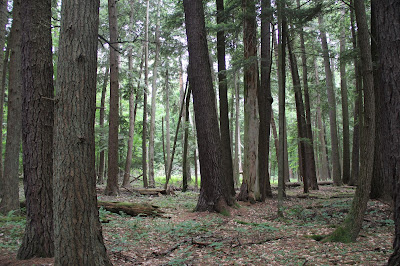I spent all of last week at the
Ralph A. McMullen Conference Center attending a forestry education workshop. This workshop was hosted by the
Michigan Forest Association and was designed to give teachers insight into past and current forestry practices. Photographs from
Day One,
Day Two, and
Day Three were posted last week while I was at the conference.
Day Four began with a review and discussion of the previous days' activities and how this information can be incorporated into the classroom. After this discussion, our next stop was a tour of the
Weyerhaeuser mill near Grayling, MI. This facility is one of six mills owned by Weyerhaeuser in North America that produces
oriented strand board (OSB). Oriented strand board is commonly used in the construction industry as sheathing for walls and for flooring and roof decking. It is made by bonding in flakes of wood (many species are used) with a blend of waxes and resins inside a very large hydraulic press. The press at the Grayling mill is capable of handling sixteen super-sized (16ft x 24 ft) panels of OSB at once. After emerging from the press the panels are cut into their standard 4ft by 8ft size. Unfortunately, I do not have any photographs of this process. Weyerhaeuser does not allow photography inside their mill to protect trade secrets.
After leaving the Weyerhaeuser plant, the remainder of Thursday was spent preparing for and doing a timber cruising exercise. During this exercise groups of teachers counted the number of 2 inch or larger trees in 1/10th acre plots. Each group of teachers did this exercise on two plots. Because there were five groups, by adding these plots together we were able to get an estimate of the number of trees per acre in the woods. Data from each group was compiled on a tally sheet before being compiled back in the classroom.
 |
| Fixed-radius plot tally sheet - used to record data during our timber cruising exercise |
In addition to counting the trees, we had to separate them into size classes and estimate their height. To do these two tasks each group was given a tool known as a
Biltmore stick. When held at arm's length against the tree, marks on the Biltmore stick give a rough estimate of the diameter of the tree.
 |
| Using a Biltmore stick to estimate diameter |
The other use of a Biltmore stick is to estimate the number of logs that can be cut from a tree. To use the stick in this manner you first have to pace a specified distance from the tree (ours were calibrated for 25 feet) and then hold the stick vertically, lining up the bottom end of the stick with the base of the tree.
 |
| Estimating height with a Biltmore stick |
To make this experience even better the instructors arranged for a rainstorm to soak the woods before and during the exercise. (The instructors didn't really make the rain happen, but it definitely added to the experience - it took two days for my boots to dry afterwards).
The workshop concluded on Friday with a panel discussion about the current and future state of the forest products industry in Michigan. I did not take any photos of this panel discussion.
Overall, I would rate this as one of the best workshops/conferences that I have ever attended. The activities were well thought out and gave a pretty complete (if condensed) picture of the forestry industry from its roots (no pun intended) to its present and future. I will highly recommend this workshop in the future.
































































